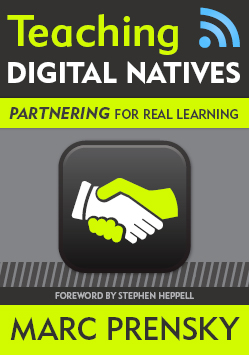
CHAPTER 1:
1. What works in the classroom today? What needs changing?
Prensky and myself are in total agreement that the most effective and engaging lessons are ones that possess a high level of creativity, meaningful discussions, and individual interests of the students within the class. School trips, group work, and other hands-on activities that immerse students in content and context work particularly well. Further, Teachers should always be energetic and respect the thoughts and opinions of their students.
Most of today’s teachers are “trained to tell,” however today’s students are not listening to their teachers. Therefore, to significantly improve the current state of American education, we must start making changing. Classrooms must be made more student-centered by utilizing student interests, “why questions,” new (and perhaps unfamiliar) technology, as well as mutual respect among classroom community members. The teacher must learn to relinquish some (if not most) of her control in an effort to yield better academic results and create young adults who are well prepared for their future in the “real world.”
2. Can we see students differently? Can we achieve mutual respect?
Because of their strong connection to (or increasing dependence on) technology, students are moving faster than any generation before them; their entire lives are organized on and around the internet, which is always extremely accessible. A boring, cookie-cutter lesson that lacks meaning is no match for the attractive flash of information beaming into a student’s pocket. Prensky suggests viewing students like a “rocket” rather than a 19th century “train on a track:” as a teacher (or “rocket scientist”), it is our job to mix the right “fuel” to allow them to do extraordinary things.
Although I don’t like his overused analogy, we must start viewing students as the intellectual, tech-savvy, young adults they actually are rather than passive containers for our lecture material. By creating an environment of mutual respect, students will be more willing to fully participate in the learning process. It will give them confidence and a drive to perform at their highest ability, which is the ultimate goal of any teacher. Further, if students sense they are respected, they will become more likely to give that respect to other members of the classroom community.
3. What is partnering? What are the teacher’s and the student’s roles?
Partnering is a form of teaching when the onus to learn is completely on the student. They must hypothesize, explore, research, self-monitor, self-correct, discuss, review, as well as any other process that might help them take control of their own education. Partnering allows students to follow their passion and to learn helpful “real world” skills. Therefore, a teacher acts as a guide, coach, and facilitator of content and context. They set goals, design engaging lessons, create questions and control the general flow of classroom activity. Although partnering is not new, it has been generally been abandoned in the current state of American Education.
However, I still have some concerns about partnering as a teaching strategy. First, given the varying abilities of students with special needs, is it possible to employ advanced partnering in a self-contained or inclusion class? Second, when I have attempted to use partnering in my own classes, students refused to work because they knew we would be reviewing the work regardless if they actually did it. Isn’t partnering only as successful as students are willing to make it? Third, as Prensky suggested, how does one partner effectively with an unwilling administration and subpar district technology?
No comments:
Post a Comment